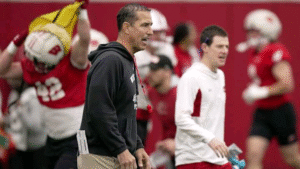
Wisconsin Badgers’ Recruiting: A Closer Look at Momentum, Rankings, and the Road Ahead Under Coach Luke Fickell
The University of Wisconsin football program has long maintained a reputation as a gritty, disciplined team within the Big Ten Conference. Following a major push in June that saw head coach Luke Fickell and his staff pull in several key commitments, it appeared the Badgers were turning a promising corner in their recruiting efforts. However, as July came and went, that once-sizzling momentum began to cool, prompting discussions among fans and analysts about the current state of the 2026 recruiting class.

This development came not from a complete halt in activity, but rather a subtle shift in focus. As the calendar moved deeper into the summer months, Fickell and his coaching personnel turned their attention toward the next wave of prospects. Instead of concentrating heavily on the current 2026 class, they began to extend scholarship offers to underclassmen — specifically, members of the 2027 and even 2028 recruiting cycles. These younger athletes, many still juniors and sophomores in high school, represent the long-term vision of the program, and the strategy suggests that Wisconsin is playing the long game in recruiting.
While such a future-forward approach is logical and potentially fruitful, it does come with short-term trade-offs. The immediate consequence of shifting energy toward future classes is a drop in relative performance within the current recruiting cycle. This dynamic is now visible in the latest national rankings.
As of the beginning of August, the Wisconsin Badgers’ 2026 recruiting class finds itself ranked 43rd in the country according to the industry composite rankings provided by Rivals. Within the Big Ten, this placement puts Wisconsin at 14th out of the conference’s 18 teams — a less-than-stellar standing for a program with aspirations of competing at the top of the league.
However, rankings alone don’t always tell the full story. While the numerical placement might look concerning, the actual score Wisconsin has accumulated in the Rivals system is very close to the group of teams ranked just above them. In fact, the difference between the Badgers and several of those ahead — including five fellow Big Ten programs — is minimal. We’re talking about fractions of a point, which could easily be reversed with a handful of quality commitments.
Still, it’s hard to ignore the optics of the situation. A drop in rankings, especially after a strong early summer, raises questions. The team also suffered a couple of notable setbacks in July as two previously committed recruits flipped their pledges to other universities. These defections didn’t go unnoticed. Losing players who were once locked in affects not only the rankings but also public perception. It introduces uncertainty and can sap some of the enthusiasm that had been building.
The Badgers’ current class composition consists of 14 publicly known commitments. Both Rivals and 247Sports — two of the major recruiting platforms — list two of those as four-star athletes, while the remaining dozen are categorized as three-star prospects. On paper, that breakdown is respectable, if not eye-popping. Yet, discrepancies between the two sites highlight how recruiting rankings can vary.
247Sports, for instance, has placed Wisconsin much lower than Rivals — ranking the Badgers all the way down at 60th nationally and 16th in the Big Ten. One explanation for the lower ranking is how 247Sports evaluates other programs, particularly in terms of how generously it doles out three-star ratings to competitors like Purdue and Northwestern. According to their metrics, those teams have more three-star players than Rivals credits them with, pushing them past Wisconsin in the standings. Meanwhile, schools like Maryland and Nebraska are still placed below the Badgers on both platforms, offering some consolation.
Despite the slide, it’s important to note that recruiting rankings are fluid by nature. There’s still a lot of time left before the 2026 cycle concludes. Prospects continue to rise, fall, and make decisions throughout the year. Official visits are still ongoing, and many top-tier talents have yet to make up their minds. National Signing Day is still months away, meaning Wisconsin has ample opportunity to climb back up the rankings and close the gap.
That said, the Badgers can’t afford to become complacent. The Big Ten is one of the most competitive conferences in college football, especially with the recent addition of powerhouse programs like USC, UCLA, Oregon, and Washington. The competition for recruits is more intense than ever, and maintaining a top-half standing in the conference recruiting rankings is critical for long-term success.
For Coach Luke Fickell, the challenge now lies in reigniting the spark that powered Wisconsin’s surge in June. That stretch saw the Badgers secure commitments from key four-star players, which significantly boosted the class’s credibility and brought positive attention to the program. Reproducing that kind of success again will be crucial if Wisconsin wants to finish the cycle strong.
Fickell’s recruiting track record, particularly from his time at Cincinnati, suggests he’s more than capable of assembling a high-level class. At Cincinnati, he demonstrated a knack for identifying underrated talent and building a cohesive unit. That experience should serve him well as he attempts to solidify Wisconsin’s class in the coming months.
Additionally, Fickell’s approach to recruiting is methodical. He values character, fit, and developmental potential — qualities that may not always shine through in early star ratings but can pay dividends on the field. In the long run, this might prove beneficial, even if it means enduring a temporary dip in rankings.
Looking forward, the key for Wisconsin will be balance. While it’s smart to look ahead and make early inroads with the classes of 2027 and 2028, it’s equally important not to lose sight of the current cycle. Relationships with 2026 prospects need nurturing, and late offers to emerging talents could help make up ground lost during the summer slowdown.
Wisconsin’s coaching staff must also be strategic in managing decommitments. In today’s recruiting landscape, flips are a reality. But proactive communication, continued engagement, and clear program vision can help reduce those losses. Re-recruiting current commits is just as vital as bringing in new ones.
Another aspect worth considering is Wisconsin’s current recruiting philosophy in light of NIL (Name, Image, Likeness) opportunities and the transfer portal. These two elements have fundamentally changed how programs build rosters. While the Badgers have not been the most aggressive team in the NIL space, an increasing emphasis on competitive packages could help them land higher-profile prospects in the future.
On the flip side, the transfer portal provides Fickell with another tool to address immediate roster needs. Should the 2026 class fall short in certain areas, there’s always the option to supplement with experienced players from other programs. Nonetheless, high school recruiting remains the foundation, and building strong classes each year is the most sustainable path forward.
As Wisconsin fans look ahead to the rest of the 2025 calendar, they’ll be watching closely to see how the team regains momentum. A couple more four-star commitments would go a long way in restoring confidence and repositioning the Badgers within both the national and conference recruiting landscape.
In the end, recruiting is a marathon, not a sprint. While July may have felt like a step back after June’s progress, the window remains wide open. With Luke Fickell at the helm, a coach who has already proven he can build competitive programs from the ground up, there is reason to believe that Wisconsin’s best recruiting days for this cycle may still be ahead.
The next few months will be critical. Whether it’s through securing more blue-chip talent, flipping key prospects from other schools, or unearthing hidden gems, the Badgers need to make a push. The goal is to bolster their current class while laying a strong foundation for the future. With consistent effort, refined messaging, and targeted engagement, Wisconsin can not only rebound but potentially surpass its previous high-water mark.
The recruiting scoreboard may show 43rd nationally and 14th in the Big Ten today, but those numbers can shift quickly. As August transitions into fall — with high school seasons starting and official visit weekends looming — every opportunity counts. The pressure is on, and the spotlight is firmly on Luke Fickell and his staff to show that the drop in July was merely a pause in what will ultimately be a winning recruiting campaign.
Leave a Reply